Exploring the diverse world of Yucca plants provides a fascinating insight into their unique characteristics and the aesthetic value they add to gardens and landscapes.
Central to understanding these plants is the question: “What does a Yucca plant look like?”
Yucca plants are known for their striking appearance, characterized by broad, spiky leaves, strong woody stems, and a resemblance to palm trees in structure.
They offer a tropical look to any setting, making them ideal for enhancing the beauty of gardens.
In this article, we delve into the various aspects of Yucca plants, including their features, types, and the specific conditions they thrive in.
With around 50 species worldwide, Yucca plants are not only diverse in their forms but also in the colors of their flowers and foliage, ranging from bluish-green to creamy white.
By understanding what a Yucca plant looks like, garden enthusiasts can make informed choices about incorporating these plants into their outdoor spaces for an elegant and tropical ambiance.
Features of Yucca Plant
Though Yucca Plant is a kind of tropical plant, it is not a tropical plant.
They are mainly famed for being tall, beautiful, and having broader leaves, and therefore, they are brought home to give a nice view of the garden.
There are approximately 50 species of Yucca plants all over the world, including Yucca trees and shrubs.
So, growing Yucca trees in your backyard will be an interesting choice.
The most special feature of the Yucca plant is that it produces many flowers at once and in a bunch.
Though they are not cacti, they do have leaves like cacti and are also perennial evergreen shrubs people want to plant in their gardens to create a beautiful and tropical look in their backyard.
They belong to the Asparagaceae plant family, and some Yucca plants look like their family trees.
These Yucca plants usually look like trees because of their cane and thick stems that provide them structure like their family tree.
Due to its spiky and broad leaves, Yucca can be identified from very far away.
Also, they produce white and pink flowers in bunches. More so, they do have different varieties that produce different color flowers, especially bluish-green and whitish-green.
The Yucca foliage ranges in different colors; some have different structures and variegation.
Their flower Yucca rises from the center and can reach up to 12 ft.
Those Yucca flowers that have bell-shaped flowers belong to a specific variety of Yucca Plants.
The trees grow in dry, sandy soil and require plenty of sunshine for their natural growth.
The soil must be enriched with enough nutrients and minerals to grow naturally.
Types of Yucca Plant
There are different varieties of Yucca plants, and they grow in different environments with a certain amount of soil and sunlight.
Though they can be grown in almost any type of soil, they require plenty of sunlight and water to grow beautiful and tall.
Also, they provide many different colors of flowers, like bluish-green and white flowers.
Some of them also produce little yellow flowers in a bunch and look more beautiful in the broad daylight.
1. Adam’s Needle
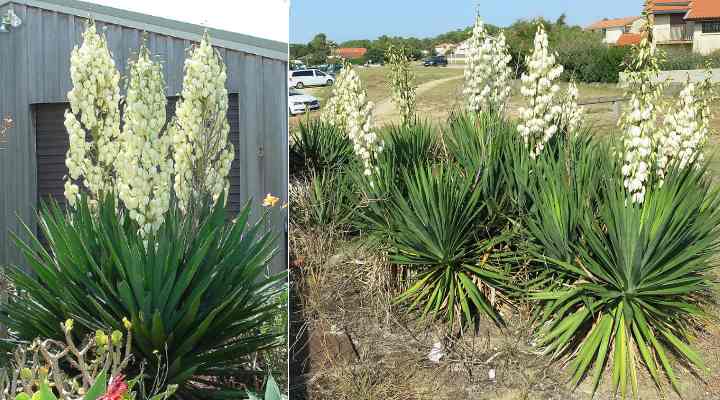
Adam’s Needle is a known variety of flowering Yucca plants, and it has a nice tall and woody stem that can bear beautiful flowers with heavy foliage.
This Yucca plant produces a bunch of white flowers, and they are so tall that they can reach up to 2.4 meters high.
Not only this, but this plant can also survive in cold, hot, and humid temperatures. All this plant requires is plenty of sunlight and water.
Adam’s needle is a famous evergreen plant with spiky leaves that are sharp and spine-tipped.
It has a cluster of white flowers and is the perfect choice for landscape plants.
More so, Adam’s Needle has many thin filaments in its foliage, which is a great way to identify the nature of this Yucca Plant.
Also, Yucca is generally good for providing an adequate amount of oxygen and thus helps protect society from various poisonous gases that pollute the environment.
Therefore, people are so fond of getting Yucca in their homes. They look exceptionally beautiful and tall and have many benefits if you take them home.
2. Color Guard
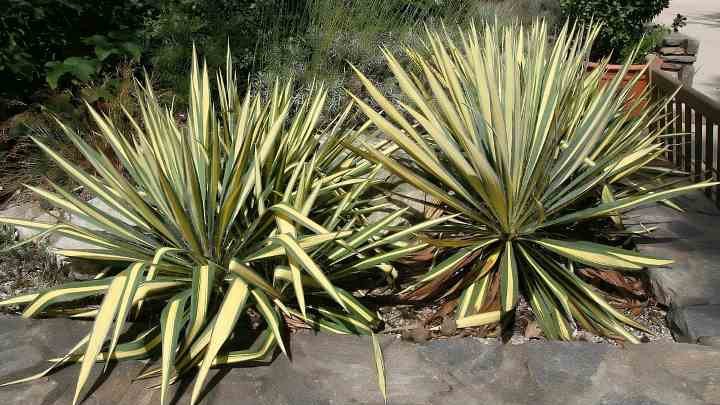
The second variety of Yucca is none other than the Color Guard. This is another special type of the Yucca family tree and is famously known as the Color Guard.
This plant gives beautiful yellow and white color flowers, and they have beautiful and dense foliage that attracts many visitors, and therefore, people always take them home.
The leaves of this Yucca plant are very tall and spiky. The leaves are also very strong and shiny. The foliage of this plant grows in a very rosette form.
This plant does not acquire much height, but it expands well. This means the plant might not get too tall, but it can take too much space in its spot because of how dense its foliage is.
More so, this variety of Yucca plants requires plenty of sunlight and should reach directly to the plant without any hindrance.
Also, the soil in which it is grown should be sandy enough to bear the nutrients and minerals.
3. Excalibur

The very next variety of Yucca plants is none other than the Excalibur plant.
This plant of Yucca is known as thread Yucca because of the threads in the plant itself.
The shrub has wooden and shady leaves that are so stiff and spiky that if you touch them, you can feel the threads in your hands.
In the summer, this plant will produce a large bunch of foliage and flowers that will be bell-shaped.
Along with this, the color of the flowers that it will produce will be white, and you can grow them indoors as the leaves are not that sharp and spiky.
As the plant matures, its stem takes the structure of an elephant foot because that is how the plant stem is too woody and hard enough to bear such cute and beautiful dense foliage.
The leaves are often too large and broad; hence, they need good support from the stem.
4. Spineless Yucca Plant
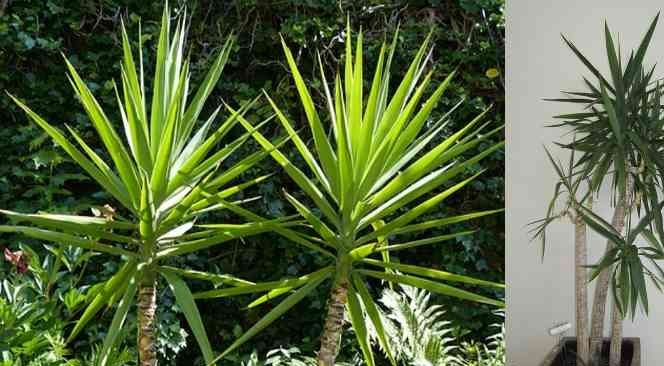
Till now, all the plants that we have discovered have spiky leaves that are large, broad, and tall.
However, this one is a little bit different, and it does not have spiky and sharp broad leaves.
Instead, it has some tall but soft and smooth leaves and that is why you can grow this plant in your home also.
Yes, this variety of Yucca plants is famous for planting inside of the home to keep the environment cool. More so, this plant is very tall, and it adds to the beauty of your home.
Spineless Yucca plants are one of those Yucca plants that are certainly suitable for being a houseplant.
If you do not want them to plant in your garden, then you can plant them inside your home.
They require sunlight and a proper amount of watering to grow well.
Other than these two things, they require nutrients and minerals that you could provide through the soil in which you are planting them.
More so, Spineless Yucca is one of the tallest Yucca plants.
5. Spanish Bayonet
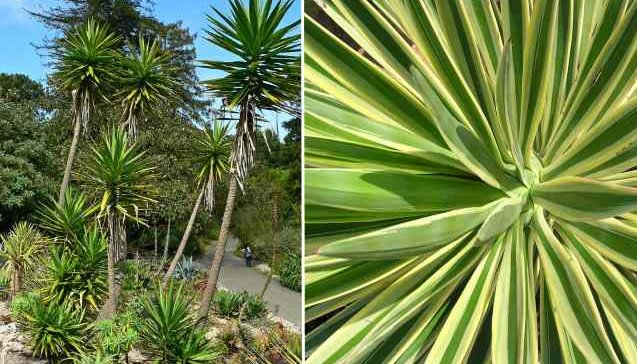
Another variety of the famous Yucca Plant is our Spanish Bayonet multi-stemmed Yucca.
This is one of the most popular Yucca species and is too ornamental. Like its name, it has broad and large leaves that are quite spiky and sharp.
The shape of its leaves follows the sword-like structure, and hence, they do not look like any other member of their family and follow a different trend. More so, they have stems that are too stiff and woody.
This Yucca Plant produces a cluster of little white flowers that appear so bright and shiny.
This is one of the best plants to take home and plant in the garden.
However, it will be difficult to plant it inside the house, but it will look equally promising and good in the garden as well.
It is also famously known as the Spanish Dagger, and it has a shrub-like structure that has dense leaves that are sharp and pointed
6. Yucca Flaccida
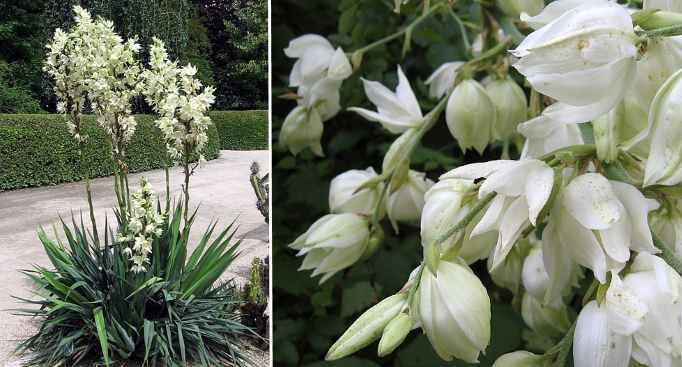
This is one of the special varieties of Yucca plants with weak leaves that easily get dropped or bend over independently.
More so, this plant does not take much height and remains up to 60 cm only.
So, this will be one of the best choices to grow inside your house.
This plant will not take much space as it is not so tall; taking care of this one will also be easy, and it will add beauty to your house as well.
Its structure can easily identify this plant as it has sword-like leaves, and the leaves are pointed at one end.
So, you can easily identify this plant and take it to your house.
This plant produces flowers in a bunch and at the end of the stem. The flowers are yellow, and they have green leaves.
Some of the varieties of this specific plant also produce white flowers, but this one is easily found, while the other is somewhat rare.
So, you can choose this one or the one with white flowers as they both need the same care.
7. Yucca Gloriosa
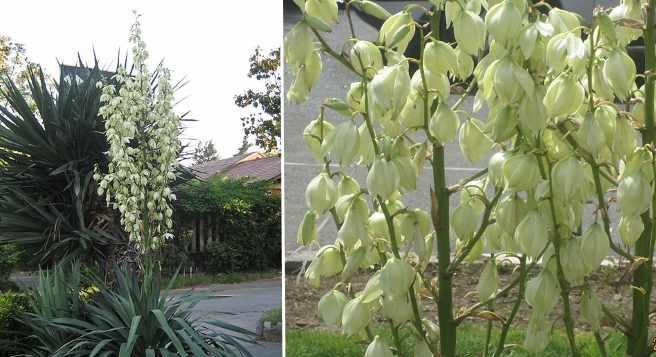
The next species of Yucca Plant is the famous Yucca Gloriosa.
It is also famously known as the Spanish Dagger but is mainly being called by its common name, Yucca Gloriosa.
Yucca Gloriosa has a sword-like structure of leaves, but they are not broad or large; they are tiny and compact.
The leaves of this plant are rich in green color and so dense that it will be difficult to glance at the flower.
The flowers of this plant are rich, creamy white. Yucca Gloriosa has many cultivators, and it is one of the most attractive plants of the Yucca family.
It gives a soothing and pleasant fragrance, and if you grow this plant inside your house, your house will have a pleasant fragrance throughout the day and night.
This plant can be grown in hot, humid, and cold temperatures and requires plenty of watering.
So, caring for this plant might be difficult for you as it requires continuous minerals and watering.
8. Red Yucca Plant

The next Yucca plant on our list is the Red Yucca Plant, and it is easy to identify this plant by the color of its flowers, which are slightly red and slightly pink.
The plant grows quite tall, and the leaves of this beautiful plant are broad and large.
The foliage is dense, and the flowers are too attractive to attract many visitors. Also, it has bluish-green leaves, and that is why it is easily identifiable.
The flowers it produces are bell-shaped, unlike the traditional sword-like shape.
This plant is, however, suitable for the Mediterranean environment and not in the usual environment.
Therefore, it is not recommended that you grow these plants in your garden.
This plant mainly requires a cool temperature throughout the year, and the temperature should be perfectly suited.
Otherwise, it will not produce flowers, and therefore, the perfect climate for this plant is the Mediterranean environment.
9. Joshua Tree
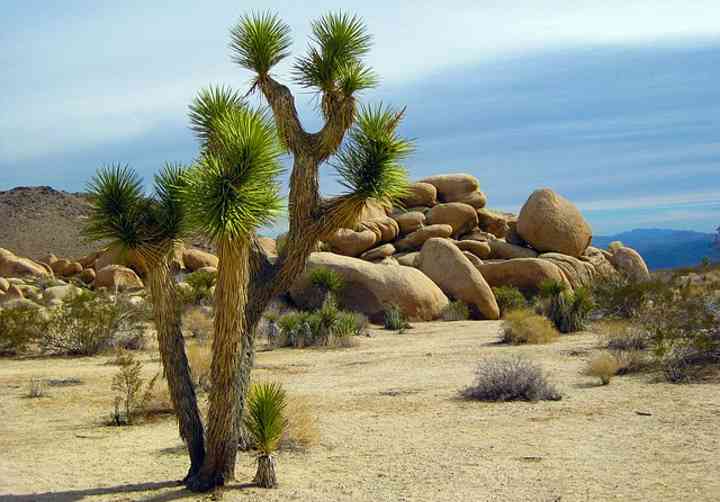
Joshua is one of the fastest-growing desert trees and a famous symbol of the Mojave Desert.
This tree is very easy to identify from far away because of its thick and woody trunk that is further divided into many branches that are again too thick and woody.
The leaves of this tree are sharp, have a dark green color, and are dense in foliage. The leaves are pointed and too sharp.
Not only this, but the Yucca tree is also very tall, and its height can reach up to 15 meters.
Its root is too strong, and the stem is quite woody and dense. Joshua tree is recommended for garden only and not for any other location.
This tree produces beautiful yellow and creamy white flowers in a cluster, and the perfect season for these flowers is early spring and late winter.
This tree does not produce flowers in the summer because it needs a cool temperature to grow.
10. Soapweed Yucca Plant
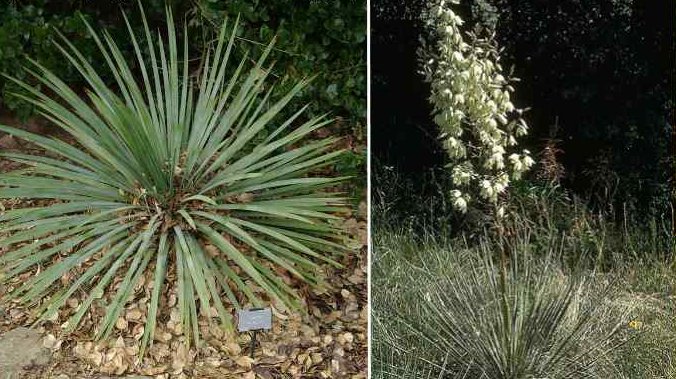
Another famous species of Yucca tree is none other than the Soapweed Yucca Plant.
This Yucca plant is shrubby, and its leaf has a sharp sword-like structure.
This plant is found in deserts, and you can easily identify it because of its long, narrow, and spiky leaves.
The height of this plant does not reach more than 0.6 meters, and it is quite compact in breadth.
Hence, this plant is suitable to be grown inside the house if you are ready to take care of it.
The Soapweed plants produce white and green flowers at the end of the stem that are not so tall but still can bear the weight of the cluster of flowers.
This plant is somewhat like the Spanish Bayonet plant, but it still has some amazing features that are not present in any other plant.
This plant is mainly grown at cold temperatures and does not require too much sunlight and watering, so it will be easier for you to take care of it.
11. Banana Yucca Plant

You must have heard about this specific plant because it is quite popular, and most people choose this plant for the Yucca family to bring home and to plant in their garden.
Have you ever wondered why? Well, this plant has specific features that are not present in any of its family members.
This Banana Yucca Plant produces small banana-shaped fruits, and they are mostly found in a deserted area.
Apart from this, the Banana Yucca Plant also has a shrubby structure to its stem and roots, and the roots of this plant are quite heavy and wooden.
This plant carries more weight than the flowers and the small fruits that are produced on the tree, and therefore, it requires a lot of nutrition and care to grow well.
Also, caring for this plant is not an easy job because it requires a continuous supply of minerals and water.
12. Mojave Yucca Plant
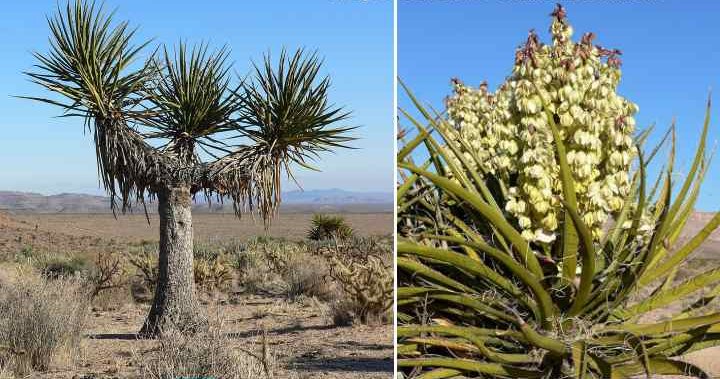
Another one on our list is the famous Mojave Yucca Plant, which is also known as Spanish Dagger.
Just like its name, the leaves of this plant are sharp and pointed towards one end.
This Yucca Plant can reach a height of 5 meters, but the leaves are dangerously sharp, and you should never touch the leaves with your hand.
It does not grow as a large tree, but the height remains like a medium-sized tree.
Apart from this, the Mojave Yucca Plant also produces a cluster of white flowers that are too small, but as they are produced in a cluster, they look beautiful.
This tree requires a lot of attention and proper handling, and only then will you be able to grow it well.
However, people normally do not consider growing this tree in their homes as it is difficult to maintain it.
If you can give additional time, then only you should think about planting this Yucca Plant in your garden.
13. Beaked Yucca Plant
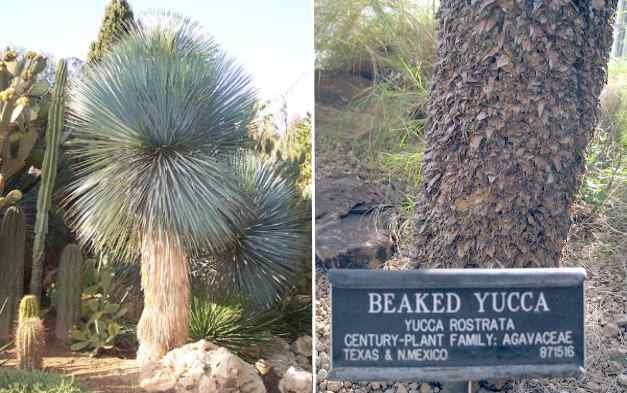
Beaked Yucca is a dense wooden stemmed plant. It has bluish-green leaves and it also has dense foliage.
The foliage is round, and the leaves take a long, thin, and pointed structure in a cluster.
This tree is neither too large nor too small, and it is one of the best choices to plant in your backyard.
Not only this but a large bunch of flowers are also produced in this tree. Along with this, the color of the flowers is slightly red and mostly white.
However, the tree grows tall enough that you cannot plant it inside of your house, but you can plant it in your garden.
This Yucca tree will also give you proper shade and requires a lot of handling and care.
Also, the perfect temperature for growing this tree is not too hot or too cold; it should be mildly cold so that it can get proper nutrition and grow well.
However, people always choose a cold temperature to grow this Beaked Yucca Tree.
14. Twisted Yucca Tree
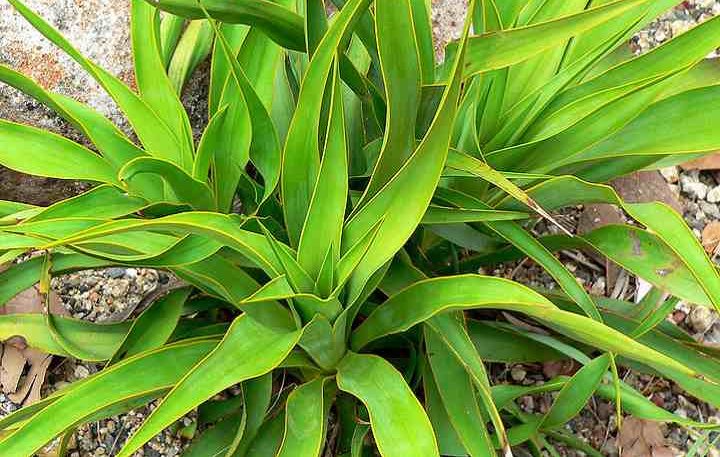
Now comes the most interesting plant of the Yucca family tree, popularly known as the Twisted Yucca Tree. It has dense foliage of light green color.
The leaves of this plant take a pointed and sharp shape, just like the Beaked Yucca plant leaves.
These are suitable for planting inside your house as well because they do not grow too tall.
The most important thing about this plant is that the flowers that it produces are white and have a small bell shape.
They emerge from plants and produce a large bunch of flowers at once.
As this tree is suitable for houses, it does require too much care and nutrition. Apart from this, a mild temperature is required to grow them well.


Can the Adam yucca make it in harsh Wisconsin winter weather?
I am learning herbalism. My instructor uses Yucca Glauca (root) medicinally. I have yuccas everywhere here in SE NM but I have no idea what yucca GLAUCA is. My instructor says that he thinks any of the yuccas will do – just not agave. How can soap root yucca have the same medicinal properties as Spanish dagger? Can you -please help me out?